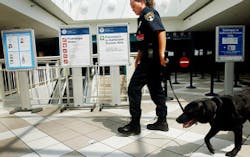Dogs in Birmingham K-9 Unit Sniff for Bombs at Airport
BIRMINGHAM, Ala. (AP) -- It took Dolly less than 10 seconds to locate the plastic explosive Semtex on Concourse B at Birmingham International Airport.
The golden-haired dog sniffed near the Czech-made explosive material hidden in a planter, sat and looked up at her partner, Birmingham Police Officer David Hale, while air travelers were screened at a security checkpoint nearby.
Routine explosive detection training like Wednesday's session are run at least twice a week by the Birmingham Police Department's K-9 explosive detection unit. The force, responsible for sweeping the airport and responding to bomb threats, will double in size by summer's end with the addition of two dogs and two officers.
Two Birmingham police officers will fly to San Antonio on Friday to train for 10 weeks with new canine partners in a Transportation Security Administration course.
The staffing increase is part of a post-Sept. 11, 2001, initiative to bolster the bomb-detection canine program, TSA spokesman Chris White said. The agency overseeing aviation security is funding the additions in Birmingham with $80,000 a year, and Birmingham is providing the officers.
Nationwide, TSA aims to have 300 teams patrol the largest airports by the end of the year, White said. Birmingham was selected because of its traffic flow and size, he said.
Hale, who has been on Birmingham's bomb detection unit for five years, said the current two teams are not enough. Hale and Sherry Goodwin, along with their bomb dogs, Dolly and Dexter, are stationed at the airport but often are called away for bomb threats or other tactical unit duties. Hale is a sniper and Goodwin is a bomb technician.
''It is not an overstatement by saying this (addition) directly makes the public safer,'' said White, adding that dogs are the quickest and most accurate way to detect explosives.
Dolly, a Belgian Malinois, and Dexter, a black Lab, search planes and luggage and do routine sweeps of the concourses. They can sniff out 11 different explosives, including dynamite, C-4 and Semtex, which Hale said currently is ''the explosive of choice.''
TSA-trained dogs correctly identify explosives 96 percent of the time, he said. That's quite an accomplishment, he said, considering that the 11 types of explosives also smell different depending on their weight.
''You take a patrol dog or a drug dog _ they can afford to miss something. But we can't afford to miss anything,'' said Hale, who has a ''K-9'' patch stitched to his right lapel. ''Someone could lose their life if we miss anything.''
The dogs respond to about 15 bomb threats a month in Birmingham and surrounding areas, Goodwin said, but they have never identified a live explosive in the airport. They were dispatched for the most recent bomb threat, in November, when an anonymous caller told the FBI that a truck was en route to the airport with a suspicious package from Osama bin Laden. Most of the time, though, they sniff ''ticking'' luggage only to find alarm clocks or electric toothbrushes, Goodwin said.
Tim Edwards and Phillip Waid, the two officers who will begin the explosive detection training on Monday, said they are excited to work with their new dogs. They will learn handling commands for the first two weeks and then be assigned dogs named after victims of the Sept. 11 attacks.
''I'm ready to go,'' said Edwards, who served warrants until now. ''I packed my clothes last week.''
